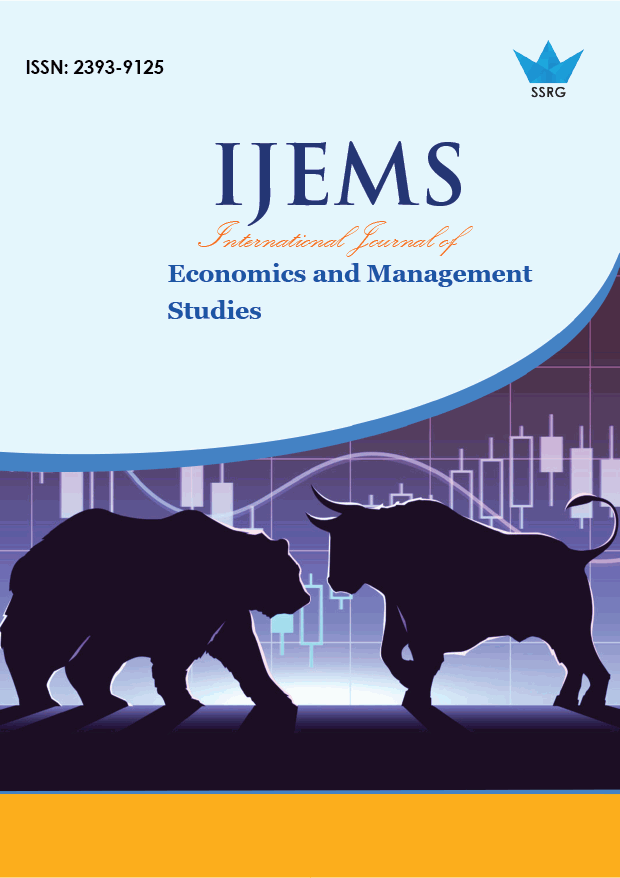Gravity Model and Trade Flow of Selected 20 Countries

| International Journal of Economics and Management Studies |
| © 2018 by SSRG - IJEMS Journal |
| Volume 5 Issue 3 |
| Year of Publication : 2018 |
| Authors : Sanjoy Kumar Saha, Nilufar Easmin, Partho Sarathi Laskar |
How to Cite?
Sanjoy Kumar Saha, Nilufar Easmin, Partho Sarathi Laskar, "Gravity Model and Trade Flow of Selected 20 Countries," SSRG International Journal of Economics and Management Studies, vol. 5, no. 3, pp. 22-30, 2018. Crossref, https://doi.org/10.14445/23939125/IJEMS-V5I3P104
Abstract:
The paper attempted to estimate trade potential for 20 countries (among those countries 19 are OECD countries and China) using the gravity model approach. The gravity model has been estimated using the OLS technique with balanced panel data of 20 countriesincluding South Korea, China and Japan from year 2001 to 2014.The dependent variable in this study is the bilateral trade flows (in US dollars), in log form, between pairs of countries. Traditional gravity models presented in the paper proved that GDP, distance and exchange rate are major significant factor for increasing international trade between those countries. Moreover we used a long set of control variables like area, population, common language, common religion, number of hours difference between the origin and destination countries, GDP per capita and entry cost to start the business etc to investigate the role of the factors that helps rising trade among those countries. Estimation results showed that common religion, entry cost, area of origin countries, population are significantly affected trade flows.
Keywords:
Gravity, landlocked, distance, exchange, trade.
References:
1.Anderson, J. E and van wincoop (2003), “Graviry with Gravitas- A solution” American Economic Review, 93, 170-92.
Aitken, N. D (1973). “The Effect of the EEC and EFTA on European cross sector Analysis”, American Economic Review, 63, 881- 92.
2.Coe, D. T and A. w. Hommaister (1999),” North South Trade: Is Africa Unusual?‟ Journal of African Economics, 8, 228-56.
3.Dabla-Norris., E., Y Ji, R. M. Townsend, and D.Filiiz Unsal, 2015.
4.Distinguishing Financial Inclusion and impact on GDP and Inequality," NBER working Paper 20821. Cambridge,
5.Massachusetts: National Bureau of Economic Rescarch.
6.Frankel, J. and S. J. Wei (199s), „Open regionalism in a World of Continental Trading Blocs „.IMF Staff Papers, 45, 440-53.
7.Feenstra, R.C., J. A. Markusen and A. K Rose (2001), „Using the Gravity Equation to differentiate among Alternative Theories of Trade‟, Canadian Journal of Economics, 34, 430 47.
8.Frankel, J. (1997), Regional Trading Blocs in the World Trading system (Washington DC: Institute for International Economics).
9.Frankel. J. and A. K. Rose (2002), "An Estimate of the Effect of Common currencies on Trade and Income‟, Quarterly Journal of Economics, 117.437- 66.
10.Frankel, J. and S. J. Wei (1993), „Trading Blocs and Currency Blocs‟. NBER Working Paper No. 4335 (Cambridge, MA: NBER).
11.Ghosh, S. Yamarik (2004), 'Are Regional Trading Arrangements Trade creating?‟ An Application of Extreme Bounds Analysis, Journal of International Economics, 63, 369- 95.
12.Hill (2009), International Business.
13.Melitz, J. (2007), "North, South and Distance in the Gravity Model‟, European Economic Review, 51.971-91.
14.IMF (2017) World Economic Outlook: Globalisation and international trade.
15.OECD (2012), Economic Policy Reforms: Going for Growth 2012, Paris.
16.OECD (2016d) World Economic Outlook.
17.Longo, R. and K. Sekkat (2004), "Economic obstacles to Explaining Intra-African Trade', World Development, 32, 1309-21.
18.Poyhonen, P. (1963) "A Tentative Model for the Volume of Trade between Countries‟, Wtwirtschaftliches Archiv, 90, 93-99.
19.Rose. A. K. (2004), “ Do we Really know that the WTO increases trade?, American Economic Review, 94, 98- I l4.
20.Tinbergen. J. (1962). Shaping the World Economy: Suggestions for an International Economic Policy (New York: Twentieth Century Fund).
21.Wilson, J. S., C. L. Mann and T. Otsuki (2003), Trade Facilitation economic development: A New Approach to Quantifying the Impact', World Bank Economic Review, 17.367-89.
22.World Bank (2006), World Development Report 2006: Equity and Development, Washington DC, World Bank and New York: Oxford University Press.

 10.14445/23939125/IJEMS-V5I3P104
10.14445/23939125/IJEMS-V5I3P104